Full-Chain Game Track Research Report: The Past, Present, and Future of Full-Chain Games
Original Author: lesley@footprint.network
Original Support: ICC Camp
With the rapid rise of blockchain technology, the global blockchain gaming market is receiving widespread attention and continuous growth, with its market value reaching hundreds of billions of dollars.
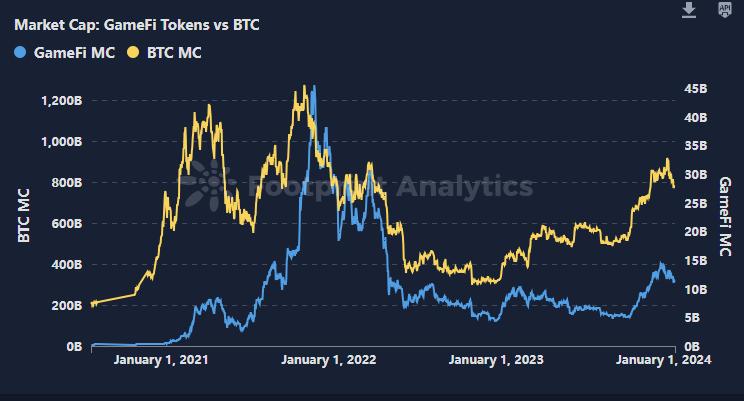
BTC vs Game Token Market Value Comparison
Full-chain games, as a new form of gaming, are gradually gaining widespread attention. Full-chain games implement all game logic and state on-chain, possessing inherent advantages of blockchain technology such as decentralization, openness, and interoperability, providing players with a new gaming experience.

This article defines what full-chain games are, outlines the origins and development of full-chain games, analyzes their significance, provides an overview of the current market situation, major competitors, and representative projects in full-chain gaming, dissects the technical and design challenges faced by full-chain games, and finally looks forward to the future trends and possible innovative directions of full-chain game development.
What are Full-chain Games? Origins, Definitions, and Underlying Technologies
1.1 Origins of Full-chain Games
Although full-chain games are still in their early stages, the imagination and related developments surrounding them have persisted for over a decade, encompassing the ideal of creating autonomous game worlds.
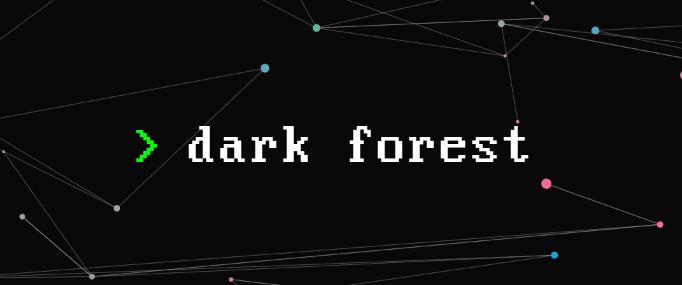
Dark Forest
2012: SatoshiDice was launched, becoming the first gambling game based on Bitcoin, marking the origin of full-chain games. The game allowed players to place bets using Bitcoin and used preset odds and a random number generator to determine winners and losers.
2013: HunterCoin emerged as a prototype of full-chain games, running on its own blockchain, where player actions were submitted as transactions, but the value of its token HUC nearly dropped to zero in 2015.
2015: The Ethereum mainnet went live, introducing a broader range of full-chain games, including gambling games like vDice and Etheroll.
2017: Crypto Kitties created the first crypto game, allowing players to collect and breed virtual cats, enriching the possibilities of blockchain gaming.
2018: Axie Infinity brought assets on-chain as NFTs and created an open and fluid SLP economy, introducing more interaction and economic innovation to full-chain games.
August 7, 2020: Dark Forest released its first beta version, combining zero-knowledge proof technology with on-chain game logic, creating a full-chain game with hidden information, no entry barriers, and scalability, but also triggering performance issues on Ethereum.
2021: The Loot Project was launched, symbolizing a foundational layer IP, spawning numerous games and applications that integrated Loot into gameplay and storylines.
2023: New types of full-chain games and autonomous worlds rapidly developed as an emerging industry, with major public chain ecosystems actively nurturing the full-chain gaming field, including rapidly developing infrastructures like LootRealms on Starknet and SUI 8192 on SUI.
As we approach 2024, we are filled with anticipation for full-chain games, with major public chain ecosystems continuously nurturing this field and infrastructure being improved and perfected. Full-chain games are not just an evolution of entertainment but also an innovative application of blockchain technology, providing players with more interaction and economic opportunities. Full-chain games will continue to explore innovation, bringing more surprises to players and becoming an indispensable part of the gaming entertainment landscape in the digital age.
1.2 Definition of Full-chain Games
Full-chain games are a game model based on blockchain technology, utilizing smart contracts to implement all game logic. In full-chain games, the entire game exists as a contract on the blockchain network, with game state storage and logic execution fully completed on-chain, aligning with the fundamental characteristics of blockchain: decentralization, permissionless access, and composability.

The characteristics of full-chain games include, but are not limited to:
Complete on-chain game logic and state: Full-chain games store all game logic and state, including assets and other information, on the blockchain and implement them through smart contracts. This means that the core operation and management of the game occur on a decentralized blockchain network, ensuring a transparent, tamper-proof, and trustless gaming experience.
Authentic source of blockchain data: The data in full-chain games does not rely on proprietary servers or auxiliary storage but is directly sourced from the blockchain. This includes not only asset ownership but also all meaningful data within the game. This approach allows games to fully leverage the programmability of blockchain, achieving permanent data storage and transparent interoperability.
Open ecosystem principle: Full-chain games are developed under the principle of an open ecosystem, with both game contracts and clients being open-source. This encourages community participation and innovation, allowing third-party developers to customize and fork new gaming experiences through plugins, third-party clients, and interoperable smart contracts.
Game-client independence: Full-chain games do not rely on specific game clients, as the game's logic and data are stored on the blockchain. This means that even if the client provided by the core developers no longer exists, the game remains playable, and the community can interact through smart contracts, ensuring the game's continuity.
Interoperability with valuable assets: Full-chain games are interoperable with digital assets on the blockchain, tightening the connection between the game world and the real world. Players can own, trade, and utilize digital assets within the game, enhancing the depth and significance of the game, linking the game world with real life.
To better develop full-chain games, developers need to continuously improve blockchain technology and consider how to optimize game design to reduce the burden on the blockchain. Proxy servers and layered architectures can also be used to help improve performance, but this may reduce some decentralized features.
1.3 Why Do We Need Full-chain Games
Full-chain games hold immense potential and importance in the gaming industry. By ensuring the eternal existence of game information, promoting open collaboration and decentralization, and facilitating interoperability between games, full-chain games provide players with a better gaming experience, enhancing their sense of investment and participation, while also bringing new opportunities for innovation and growth to the gaming industry.
Eternal existence of game information: In traditional games, when game servers go offline or terminate services, users' game assets and progress are often lost, which can lead to significant dissatisfaction and loss for players. However, full-chain games achieve the eternal existence of game information by recording all game logic and state on the blockchain. Once deployed on the blockchain, these games become permanent, allowing players to continue playing anytime and anywhere, as long as there is blockchain network support, without worrying about game shutdowns or asset loss.
Open collaboration and decentralization: Full-chain games adopt open-source code and permissionless structures, empowering players to customize and modify their favorite game content, transforming them from passive consumers into creators of the game. This not only brings more participation and investment to the game's success but also stimulates players' creativity and community building. The democratization of the game development process reduces development costs while increasing the potential for innovation. The openness of full-chain games means that players can contribute to the core game while also contributing to external matters, promoting broader collaboration and innovation.
Interoperability between games: A revolutionary concept is the transferable PoGW Token, which allows players to transfer value between different game worlds. This concept will fundamentally change the gaming industry, shifting the focus from asset portability to interoperability and universal reputation. Players can invest time and effort in one game and then transfer it to another, while also trading these PoGW Tokens with other players or even using them as a means of payment for goods and services. This economic superstructure will be shaped by the intricate and interdependent relationships between individuals, assets, NFT bundles, and various smart contracts, connecting different gaming economies through the synergies they generate. This interoperability provides tremendous potential for creating more derivative products and gameplay, enhancing connections and collaboration between games, and offering players more choices and experiences.
Overview of Full-chain Game Development, Market Situation, and Major Competitors
2.1 Full-chain Game Engines
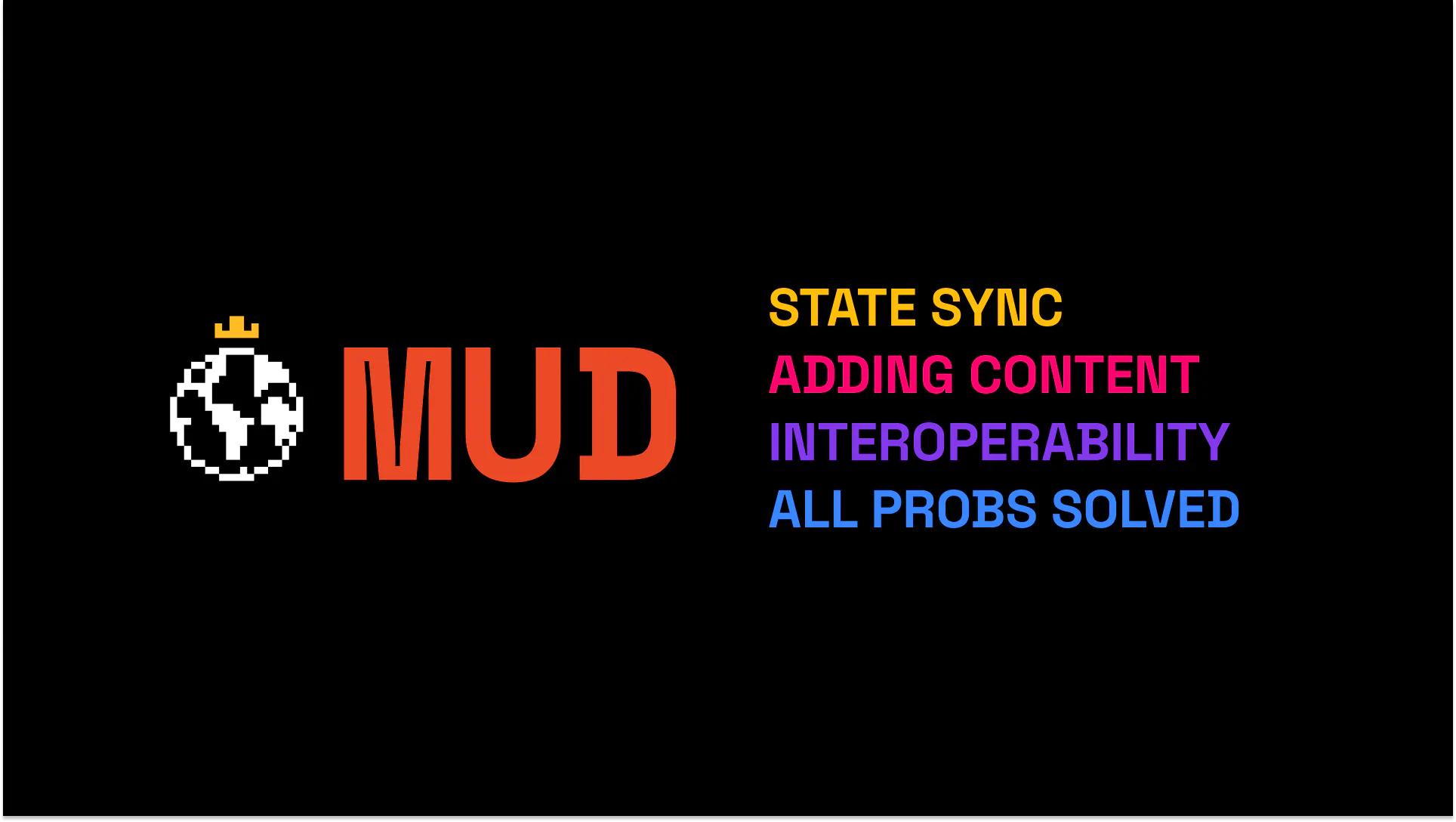
MUD
Current mainstream full-chain game engines include: MUD, DOJO, World Engine (Argus), Keystone (Curio), Paima Engine, etc. The current full-chain game engines have the following characteristics:
Adoption of Entity-Component-System (ECS) architecture: ECS is a data-oriented game development architecture that can improve development efficiency and runtime performance. Mainstream full-chain game engines like MUD, Dojo, World Engine, etc., have adopted this architecture.
Provision of on-chain data storage and state management: The engine provides standardized data storage and state management on-chain, such as MUD's Store, simplifying the complexity of on-chain game development for developers.
Support for high-performance on-chain computation: Optimized for gaming scenarios, supporting higher TPS and lower latency, such as customized chain designs in World Engine.
Emphasis on developer experience: Providing convenient development tools and pre-built contract modules, lowering the development threshold, allowing more developers to participate in full-chain game construction.
Highly modular and open: Third parties can extend and customize based on interfaces, and can also develop plugins to enrich game functionality.
Compatibility with mainstream blockchains and languages: Can be deployed on mainstream blockchains like Ethereum, StarkNet, etc., supporting languages like Solidity, Cairo, etc.
Some have their own Layer 2 solutions: MUD and World Engine have integrated their own rollup solutions to achieve higher performance.
2.2 Full-chain Game Developer Tools
Despite the immense potential in this field, full-chain game development faces numerous challenges. Developers often need to tackle technical complexity and resource limitations when creating such games. To overcome these challenges, many innovative development tools have emerged, aiming to simplify the production process of full-chain games and enhance efficiency and feasibility.
PixeLAW: PixeLAW features a layered architecture design, encompassing a core layer and an application layer. The core layer is responsible for providing the foundational systems and components, while the application layer calls the core layer's interfaces through smart contracts for game development. This architecture allows for the construction of a game development environment in minutes and, through a front-end and back-end separation strategy, enables developers to focus solely on writing back-end smart contracts, significantly simplifying the complexity of full-chain game development.
With PixeLAW, developers can reuse its core systems, avoiding redundant development of underlying functionalities, thus concentrating on developing game logic contracts.
It greatly reduces the development cycle, allowing game development and release to proceed directly without waiting for the development of front-end and back-end interaction interfaces.
By adopting a layered architecture and open-source code, PixeLAW supports parallel development work by different developers, promoting broader game innovation and combinations, bringing unprecedented flexibility and efficiency to the full-chain game development field.
ZKWASM: ZKWASM, innovated by Delphinus Labs, is a zero-knowledge virtual machine (zkVM) specifically designed to execute wasm code and generate corresponding execution traces as zkSNARK proofs. It provides the infrastructure for developing provable games. Traditionally, deploying game logic entirely on-chain faces challenges due to the computational limitations of the Ethereum Virtual Machine (EVM), affecting the feasibility of game development. ZKWASM enhances game performance while ensuring its credibility through a "off-chain execution, on-chain verification" strategy, utilizing generated wasm code execution proofs.
Developers can write core game logic in Rust and generate wasm code, which ZKWASM then executes and generates execution proofs. These proofs can subsequently be submitted to the blockchain to verify off-chain game computations, optimizing game performance and supporting more complex game designs.
ZKWASM opens up new avenues for developers in full-chain game development, allowing complex game logic to be proven off-chain while maintaining the on-chain verifiability of game data.
The Zinity solution provides developers with a convenient path to develop games using C# in game engines like Unity, compile them into wasm, and run them on ZKWASM, greatly simplifying the full-chain game development process.
Web3Games.com: Web3Games.com positions itself as a decentralized crypto game ecosystem and blockchain network, utilizing Layer 2 technology to achieve comprehensive on-chain gaming. The platform aims to accelerate the deep integration of the gaming industry with Web3 technology, intending to empower players with "ownership" in the gaming world, thereby enhancing transparency and participation in games. It provides developers with a comprehensive infrastructure that includes a game-specific blockchain, development toolkits, and a developer community to support the development of full-chain games.
By providing a Layer 2 blockchain network, Web3Games.com enables developers to easily deploy games on this network. Based on Layer 2 technology, the platform offers a secure and efficient on-chain environment to meet the demands of modern game development.
The development toolkit includes various auxiliary modules, significantly lowering the technical threshold for game development. These modules cover wallet services, contract templates, virtual goods stores, and gas fee optimization, aiming to simplify the development process and allow developers to focus more on game creation itself.
Additionally, Web3Games.com has established a vibrant developer community, providing rich learning resources and communication platforms to accelerate developers' learning and development processes through tutorials, forums, and other forms. This community not only helps developers master the skills of full-chain game development but also promotes knowledge sharing and the exchange of innovative ideas.
2.3 Full-chain Game Chains
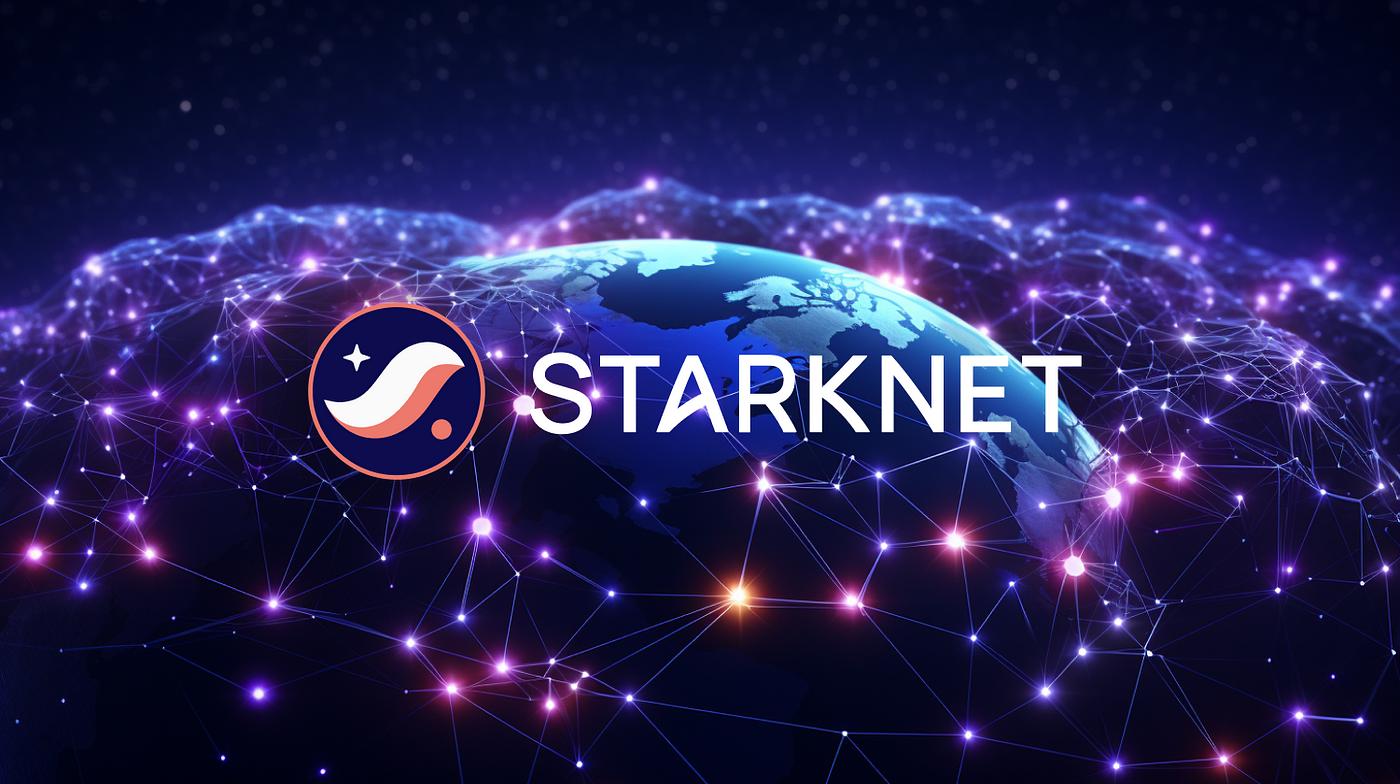
Starknet
The development of full-chain games relies on high-performance, low-cost public chain infrastructure. Currently, mainstream choices include:
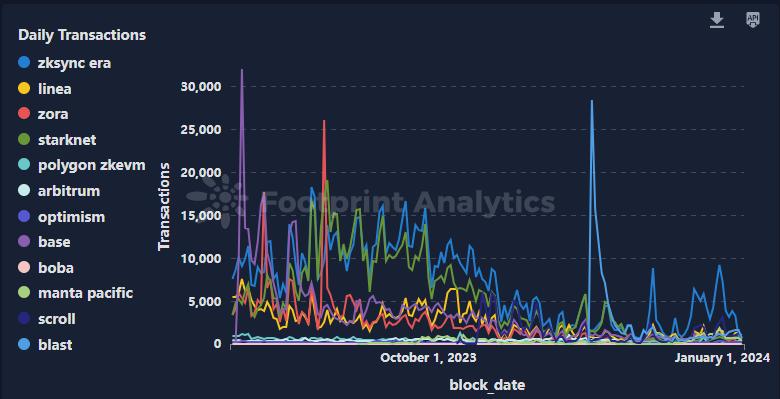
Layer 2 Public Chain Daily Transaction Volume Data
Layer 2 solutions: Arbitrum, Optimism, ZKSync, etc., provide higher transaction throughput and lower fees than Ethereum's main chain, lowering the operational threshold for full-chain games. This is also the choice for many current full-chain games.
Customized public chains for gaming: Some teams have developed customized gaming public chains based on existing public chain frameworks, introducing mechanisms like Tick to better meet gaming needs. For example, World Engine based on Cosmos and Curio based on OPStack. These public chains can further unleash the potential of full-chain games.
Next-generation general-purpose computing public chains: For example, Starknet provides high-performance computing capabilities and can also support full-chain games. However, general-purpose public chains may lack some customization.
In addition, full-chain games also require ecological support, including services such as asset trading, lending, social interaction, and distribution, in addition to public chain infrastructure. Some centralized gaming platforms are also actively embracing blockchain, bringing user and traffic benefits to full-chain games.
Overall, full-chain games are still in their early stages, and both public chain technology and ecosystems need further development. However, the future potential is enormous and worth looking forward to.
2.4 Full-chain Game Projects
Full-chain game projects currently face challenges in exploration and development. Although some researchers and developers have participated, a large-scale market has yet to form. Representative full-chain game projects remain relatively rare for the average user. Even seasoned developers may only be familiar with a few early projects, such as "Dark Forest," while other projects are mostly in testing phases, attempting to mimic and draw from traditional Web2 gaming models.
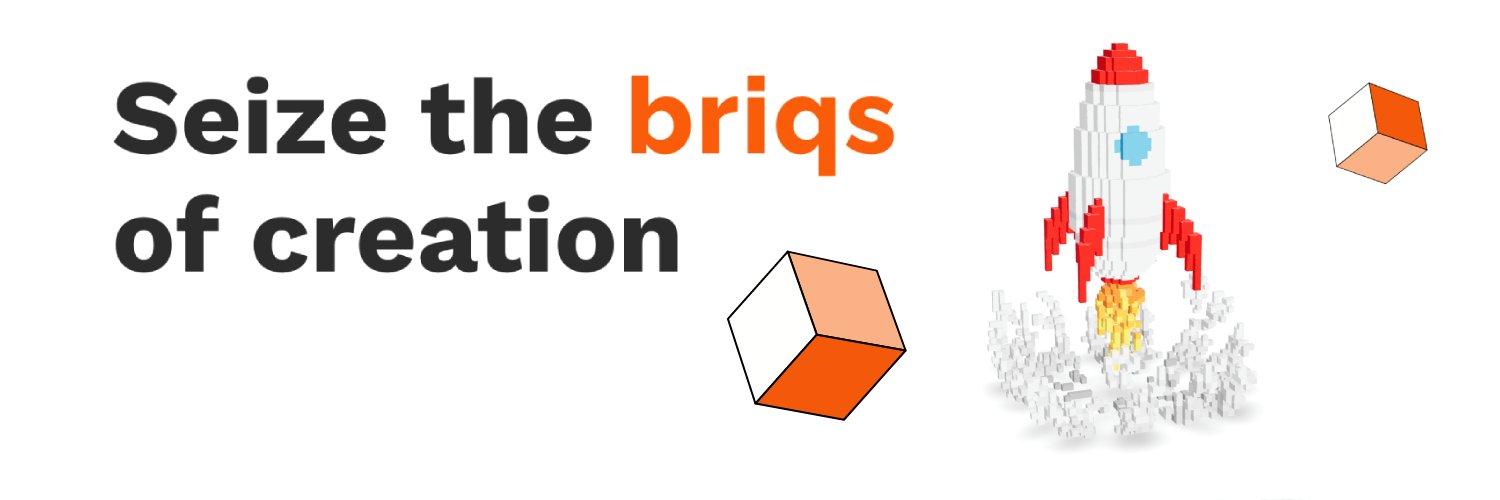
Briq
Dark Forest: A flagship full-chain game, a space strategy game that uses zkSNARKs to achieve information confidentiality, with an active community ecosystem.
Loot Survivor: An adventure game written in Cairo language smart contracts, featuring a Play 2D ie economic model.
Treaty: A strategy game on the Sui chain that allows for the signing of smart contract treaties, resource development, and trade.
Wolf Game: A resource collection and farming game with a risk protocol mechanism, featuring staking and delegation modes.
Go L2: A life game simulation built on StarkNet that can integrate with AI-generated content technology.
LootRealms: An infinite strategy game on StarkNet where players need to manage nations and build armies to protect resources.
Briq: Allows the creation of NFT building blocks on StarkNet.
SUI 8192: A mobile game where all logic and state changes occur on the Sui chain.
NoGame: A space-themed MMORPG.
SkyStrife: Features fast-paced RTS combat, allowing the community to develop Three Kingdoms games based on it.
In this exploratory phase, full-chain games need to strengthen the development of infrastructure, including full-chain game engines and related facilities, such as Starknet. However, more importantly, enhancing user experience and expanding the user base is crucial for promoting the sustained growth of the blockchain gaming market.
2.5 Full-chain Game Platforms
Unlike mature fields such as DeFi, the number of full-chain game platforms is relatively limited, making it difficult for users to easily explore and choose projects that suit them. For full-chain game enthusiasts, discovering new full-chain games often relies on word-of-mouth and the reputation spread within small communities.

0x PARC
matchboxDAO is a platform incubating games in the Starknet ecosystem. It supports developers by hosting events and directly participating in incubating game projects.
Cartridge is a Starknet game aggregation platform, similar to Steam, providing both gaming experiences and serving as game infrastructure. It aggregates multiple games on Starknet and promotes the development of Dope Wars.
0x PARC was created by the founder of Dark Forest, focusing on the forefront exploration of full-chain games.
Composable Hub is an aggregation platform focused on full-chain games under Composablelabs, being one of the early platforms to pay attention to full-chain games.
Challenges Faced by Full-chain Games
Like any emerging technology, full-chain games bring unprecedented opportunities while facing a series of significant challenges.
These challenges involve not only technical aspects, such as network performance and scalability issues, but also game design, user experience, privacy protection, and multiple other areas. Addressing these challenges is crucial not only for the development of full-chain games but will also have a profound impact on the future of the entire gaming industry.
Performance and scalability issues: A core challenge for full-chain games is that their complete reliance on blockchain technology can lead to network congestion and delays, severely affecting the gaming experience. To address this challenge, developers need to explore and implement scalability solutions such as Layer 2 solutions and sharding technology. Such technological innovations help improve the processing capacity of blockchains, particularly in terms of transaction throughput and confirmation speed.
Game design limitations: Current limitations in blockchain technology performance may prevent full-chain games from achieving complex game mechanics and real-time interactions, limiting the diversity of game types and gameplay. For example, game types that heavily rely on real-time interaction, such as Multiplayer Online Battle Arena (MOBA), First-Person Shooter (FPS), or Real-Time Strategy (RTS) games, are difficult to implement in the existing full-chain environment. Therefore, strategy games are currently more suitable for full-chain gaming, while game types that require high real-time performance, such as RPGs, Action Games (ACT), and MOBA, still face technical and infrastructure limitations.
User barriers and transaction costs: Full-chain games have a higher user barrier compared to traditional games, as players need to learn and use crypto wallets. Additionally, every game action must be submitted as a blockchain transaction, incurring corresponding fees (such as Ethereum's gas fees), which undoubtedly increases the cost of participation for players.
Privacy leakage risks: The public and transparent nature of blockchain may expose player data and transaction information in full-chain games to privacy leakage risks. To address this issue, technologies such as zero-knowledge proofs and privacy computing may need to be introduced to protect players' private information.
Balancing decentralization and game playability: While complete decentralization brings innovation and freedom, it may also lead to instability in game experience and quality. Therefore, full-chain game teams need to maintain the fun and stability of core gameplay while providing players with enough space for innovation and game expansion. This means finding a balance between complete centralization and decentralization to ensure that games maintain high quality while encouraging player participation and innovation.
Looking Ahead to the Future of Full-chain Games
The future of full-chain games is filled with exciting possibilities.
The role of AI in games and its impact on reality: As full-chain games develop, artificial intelligence (AI) plays an important role. AI not only enhances the gaming experience but also provides valuable data and insights for the real world by analyzing players' interactions and decision-making processes within the game. For example, in strategy simulation games, players' decisions and strategies can be used to optimize real-world decision models, especially when simulating complex economic or social systems. At the same time, blockchain technology enables players to truly own their data and gain benefits through on-chain interactions, increasing user engagement and potentially having a positive impact on real life.
Innovative gameplay in full-chain games: Full-chain games are expected to lead many innovative core gameplay mechanics that may not only impact the DeFi (Decentralized Finance) sector but also provide new inspiration for traditional game design. Full-chain games not only give birth to entirely new game mechanics and gameplay, such as creating trading systems based on real economic principles, but also reconstruct player incentive mechanisms, making game achievements valuable in the real world. Additionally, the decentralized governance model of full-chain games, such as DAO-like structures, enhances transparency and fairness while encouraging community members to participate more actively in the decision-making process of the game. These games also promote the development of user-generated content by granting players more creative freedom and asset ownership, enriching the gaming ecosystem and enhancing community engagement.
The trend of openness and decentralization in full-chain games: In the future, full-chain games may be more closely integrated with DAO (Decentralized Autonomous Organization) governance structures. As development tools mature, ordinary players may be able to utilize these tools to realize their unique ideas. This increase in openness and ease of use may accelerate innovation within the gaming ecosystem, bringing new business models and opportunities to the gaming industry.
Full-chain games represent the future direction of the gaming industry. They not only innovate game mechanics and gameplay but also redefine game incentive mechanisms and community governance. With continuous technological advancements, we can expect to see more innovations and breakthroughs, as full-chain games will continue to bring new business models and opportunities to the gaming industry while providing players with more freedom and control, allowing them to create unique experiences in the gaming world. This future is filled with infinite possibilities.
ICC Camp is an accelerator focused on the Web3 gaming track, aiming to help Web3 game entrepreneurs realize their dreams from concept to market launch, receiving strong support from industry organizations such as the Asia Blockchain Game Alliance (ABGA) and Web3 Labs. The accelerator program is now open for enrollment, and we welcome interested game startup teams to participate actively. Enrollment is officially open for game entrepreneurs to join our accelerator program.
Enrollment link: https://forms.gle/VsfoWxawGxhAi92d 7
Footprint Analytics is a blockchain data solution provider. With cutting-edge artificial intelligence technology, we offer the first no-code data analysis platform in the crypto field and a unified data API, allowing users to quickly retrieve over 30 public chain ecosystems' NFT, Game, and wallet address fund flow tracking data.









